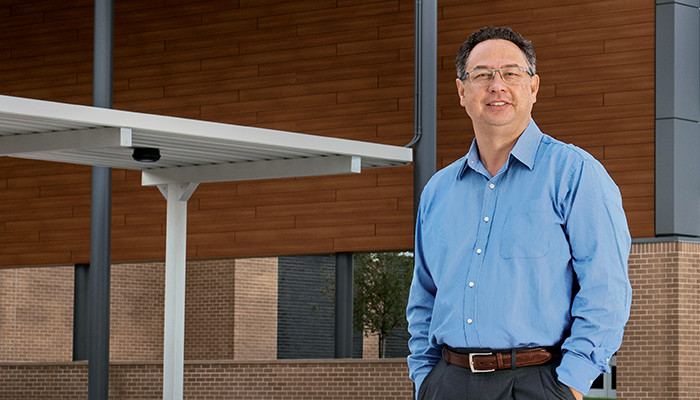Schools need to have the bandwidth and network capacity to support the emergence of future learning technologies, says Dean Murphy, network communications manager at Killeen ISD. Photography by John Davidson.
Like educators in many districts across the country, Killeen teachers have relied heavily on video collaboration platforms such as Zoom to connect with their students. And even before the switch to remote learning, teachers were increasingly using bandwidth-intensive digital resources such as online videos, meaning that any lags or jitters in network performance would have a negative impact on teaching and learning.
Before upgrading its core infrastructure, Killeen was nearly maxing out its network, hitting 98 percent utilization during the busiest parts of some days. Since the upgrades, network use is averaging about 30 percent of capacity. “You need to be ready for future growth and for the emergence of future learning technologies,” Murphy says. “You have to be ready for the bandwidth and network capacity those things are going to use. Being proactive allows you to have things ready so that students can continue their learning experience without any interruptions.”
DISCOVER: Why should schools keep Wi-Fi 6 in mind when planning network upgrades?
Connecting Students and Mitigating Digital Disparities
Remote instruction only works if students can actually connect, says Andrew Moore, CIO for Boulder Valley School District in Colorado. His district, where 20 percent of students are eligible for free and reduced-price lunch, has made a concerted effort in recent years to ensure that as many students as possible can access learning resources.
In 2013, Moore ran BVSD internet to a public housing development where 60 students lived, and the city put up wireless access points. However, because he used infrastructure paid for by the federal E-rate program, Moore unwittingly violated federal law. The district has been waiting for years for the Federal Communications Commission to rule on a waiver that would allow the use case. Meanwhile, Moore has worked to find other ways to connect students. The district is allowing an over-the-air internet provider to put equipment on its property in exchange for free internet for some students. And the district has also mounted outdoor wireless access points at two schools to enable “drive-up” Wi-Fi access.
“Every day that goes by, students who are not connected are not getting an equitable learning opportunity, and that’s a travesty for our nation,” Moore says.
The district’s own IT network remains important, especially in the current context. Boulder Valley plans to start the school year with fully remote instruction, but teachers are encouraged to come in and teach from classrooms using a district-designed setup called the Remote Education Video Audio System (REVAS).
The system features a 1080p webcam, 60-inch tripod, 27-inch monitor, Google Meet software and Chromebooks. The system also relies on two video feeds for each teacher, including an HD video feed, requiring robust network infrastructure, Moore notes.













